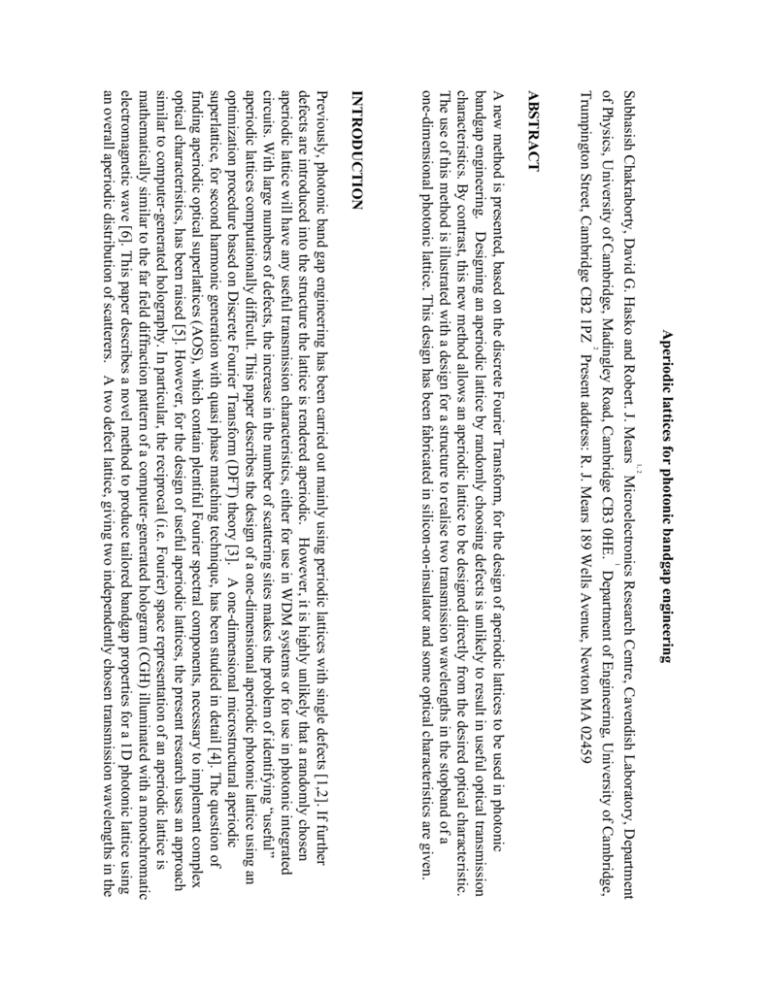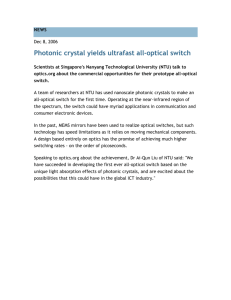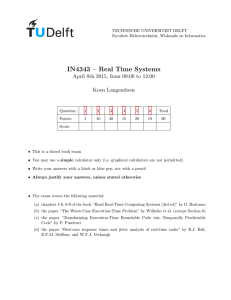mrsproc-04 - University of Cambridge
advertisement

Aperiodic lattices for photonic bandgap engineering
1, 2
Subhasish Chakraborty, David G. Hasko and Robert. J. Mears Microelectronics Research Centre, Cavendish Laboratory, Department
1
of Physics, University of Cambridge, Madingley Road, Cambridge CB3 0HE. Department of Engineering, University of Cambridge,
2
Trumpington Street, Cambridge CB2 1PZ Present address: R. J. Mears 189 Wells Avenue, Newton MA 02459
ABSTRACT
A new method is presented, based on the discrete Fourier Transform, for the design of aperiodic lattices to be used in photonic
bandgap engineering. Designing an aperiodic lattice by randomly choosing defects is unlikely to result in useful optical transmission
characteristics. By contrast, this new method allows an aperiodic lattice to be designed directly from the desired optical characteristic.
The use of this method is illustrated with a design for a structure to realise two transmission wavelengths in the stopband of a
one-dimensional photonic lattice. This design has been fabricated in silicon-on-insulator and some optical characteristics are given.
INTRODUCTION
Previously, photonic band gap engineering has been carried out mainly using periodic lattices with single defects [1,2]. If further
defects are introduced into the structure the lattice is rendered aperiodic. However, it is highly unlikely that a randomly chosen
aperiodic lattice will have any useful transmission characteristics, either for use in WDM systems or for use in photonic integrated
circuits. With large numbers of defects, the increase in the number of scattering sites makes the problem of identifying “useful”
aperiodic lattices computationally difficult. This paper describes the design of a one-dimensional aperiodic photonic lattice using an
optimization procedure based on Discrete Fourier Transform (DFT) theory [3]. A one-dimensional microstructural aperiodic
superlattice, for second harmonic generation with quasi phase matching technique, has been studied in detail [4]. The question of
finding aperiodic optical superlattices (AOS), which contain plentiful Fourier spectral components, necessary to implement complex
optical characteristics, has been raised [5]. However, for the design of useful aperiodic lattices, the present research uses an approach
similar to computer-generated holography. In particular, the reciprocal (i.e. Fourier) space representation of an aperiodic lattice is
mathematically similar to the far field diffraction pattern of a computer-generated hologram (CGH) illuminated with a monochromatic
electromagnetic wave [6]. This paper describes a novel method to produce tailored bandgap properties for a 1D photonic lattice using
an overall aperiodic distribution of scatterers. A two defect lattice, giving two independently chosen transmission wavelengths in the
stopband is used to illustrate the ability to of this method to tailor the bandgap properties. Such structures are useful in microphotonic
integrated circuits at optical telecommunication wavelengths, which requires microscale optical elements. We have used the
silicon-silicon dioxide system, which provides a sufficiently large contrast (the refractive index difference ∆n is about 2) to realize an
efficient optical waveguide at the important communications wavelength of 1.54 µm. The optical wave is strongly confined, so that
the waveguide cross-section can be made very small (in this case 0.5 µm wide and 0.26 µm thick). The aperiodic lattice is
implemented using a number of 200 nm diameter holes placed along the centre line of the waveguide. Particular attention has been
paid to sidewall roughness of the waveguide, which leads to undesirable scattering of the optical wave and transmission losses [7].
The techniques used to fabricate the waveguides used in this study have been developed to minimize the roughness. It is important that
the propagation loss is minimised for any photonic structure in an integrated circuit, and the magnitude of the loss can be measured
using the Fabry-Perot resonance method [8].
THEORY
This theory is based on two ideas. First, for bandgap engineering it is important to dope an otherwise pure (i.e. periodic) real space
lattice with defects (missing or extra scattering sites). Second, a useful aperiodic lattice, doped with multiple defects, can be
distinguished from any randomly chosen aperiodic lattice (non-useful) by defining a well-defined spatial frequency set {Gi}. It is
important to realize that the spectral response of an aperiodic lattice is closely related to its Fourier Transform; the spatial frequency
set is found by taking the Fourier transform of the lattice. It is well-known that a single defect, in an otherwise periodic structure, leads
to an allowed “defect” transmission state within a wide photonic stop band (Fig. 2). We have extended this approach to design a
structure with multiple defects, which results in overall aperiodicity, to achieve two completely isolated high transmission defect states
within a wide photonic stop band. The design process is as follows: We start with a length of periodic scatterers to form a trial lattice.
The spectral response of the trial lattice is calculated using the Discrete Fourier Transform method described elsewhere [3]. The
difference between the desired spectral characteristics and the actual spectral response is then calculated and used as the cost function
of an iterative optimization process. The process proceeds by randomly either inserting or removing defects in at least one of the
scattering sites and recomputing the cost function; if the recomputed cost function falls below a predetermined cost function value the
corresponding now aperiodic lattice is selected and the process continues for further optimization. Small increases in the cost function
are also accepted, in the early stages of the optimization process, according to Maxwell-Boltzmann classical probability statistics. This
is essential to make sure that the search process avoids being trapped in any local minima. The process is terminated after a
predetermined number of iterations or when the overall aperiodic lattice provides the desired spectral response. Fig. 1(b) shows an
optimal aperiodic lattice solution for the spectral characteristic shown in Fig.
3. This optimized structure may not necessarily be a globally optimized structure, which is mathematically difficult to obtain unless
the entire search space is investigated. However because the number of scattering sites is small (only eight in this case), the
TM
possibility of further optimization is limited. The design was carried out using a software program written in MATLAB . The
spectral characteristics shown in Fig. 2 and 3 were carried out using a commercial software package, FIMMPROP-3D, and has been
discussed in detail elsewhere [9].
Figure 1. Schematic diagrams of single (a) and double (b) defect one-dimensional photonic lattices.
Normalised Transmission
1.0
0.9
0.8
0.7
0.6
0.5
0.4
0.3
0.2
0.1
0.0
Normalised Transmission
1.0
0.9
0.8
0.7
0.6
0.5
0.4
0.3
0.810.860.910.951.001.051.101.141.191.241.29
Normalised Frequency
Figure 2. Optical transmission characteristics of the lattice in Fig. 1(a).
0.2
0.1
0.0
FABRICATION
Normalised Frequency
0.810.860.910.951.001.051.101.141.191.241.29
Figure 3. Optical transmission characteristics of the lattice in Fig. 1(b).
The fabrication techniques used to form the low loss aperiodic waveguides have been discussed elsewhere [10], a brief description
follows: Waveguides are made using Unibond silicon-on-insulator (SOI), consisting of a lightly doped single crystal silicon layer of
0.26µ m thickness, isolated by a 1µ m thick silicon dioxide layer from the undoped silicon substrate. Electron beam lithography is
used to pattern a hard mask against reactive ion etching using CF4:SiCl4 to form the waveguide. This has been found to produce
waveguides with lower roughness than when the resist is used as an etch mask directly. Finally, optical facets were formed at the
ends of the waveguide in unthinned SOI substrates using a custom made tool. A schematic drawing of the device and SEM image of
the hard mask to form the device are given in Fig. 4. The cleaved facets at the ends of the waveguide act as mirrors, due to internal
reflection at the air-silicon interface, so defining a FP cavity with the length of the waveguide defining the cavity length.
OPTICAL PROBING
The effective index (group index of the guided mode) and the propagation loss around the wavelength of 1550nm have been measured
using a Fabry-Perot (FP) resonance technique. In this measurement, light from a tuneable laser source laser source was coupled into
the waveguide using a conical-shaped lensed fibre (minimum spot size of ~5 µ m and focal length of ~15 µ m) and the transmitted
light was measured using a power meter. The intensity of the transmitted light from the optical mode in the waveguide is measured,
for a constant power of the input light, in the FP resonance technique, resulting in the transmission spectrum shown in Fig. 5.
BR
Figure. 4 Schematic drawing of the device and SEM image of the hard mask used to form the device.
1545 1546 1547 1548 1549 1550 Wavelength
(nm)
Figure. 5 Transmission spectrum in the passband for a typical device.
If the two facets have identical power reflectivity R, the propagation loss coefficient α is given by [9]
.
2
R=
n0 − neff
1
1
α= −
ln
L
R
where Pmax and Pmin are the maximum and minimum power of each resonance respectively. The reflectivity R is given by
n0 + neff
2
n
eff
=
eff is the effective refractive index of the waveguide mode, n0 the refractive index of air, i.e.=1. The effective refractive index can
be measured from the FP spectral characteristics using the formula for Free Spectral Range (FSR), which is given by
λ
2L∆λ where L is the length of the waveguide, λ is the wavelength and ∆λ is the spacing between neighboring resonance peaks in
FP spectral characteristic (FSR). For the aperiodic waveguide described earlier the cavity length L was 1mm and the spacing ∆λwas
found to be 0. 3 nm, so that eff was ~4. The reflectivity R and the ratio Pmax/Pmin were 36% and ~2.5 respectively, so that the average
-1
propagation loss α was better than 5 cm (or ~20dB/cm).
CONCLUSIONS
A new method, based on the discrete Fourier Transform, for the design of aperiodic lattices, for use in photonic bandgap
engineering, has been described. The use of this method has been illustrated by the design of a two-defect structure giving two
transmission lines in the stopband.
Devices have been fabricated in silicon-on-insulator and characterised optically. This system is shown to realise structures with very
low loss.
ACKNOWLEDGEMENTS
We wish to thank Dr Michael C. Parker, Fujitsu Telecommunications Europe Ltd. for many
useful discussions on developing the theory of this work. Also we wish to thank Professor Ian
White, Cambridge University, for use of the optical measurement facilities of the Centre for
Photonics systems, and to acknowledge help of Dr. Chris Morgan, Cambridge University in FP
resonance measurement.
REFERENCES
1.
1.
J. S. Foresi, P. R. Villeneuve, J. Ferrera, E. R. Thoen, G. Steinmeyer, S. Fan, J. D.
Joannopoulos, L. C. Kimerling, H. I. Smith and E. P. Ippen, Nature, 390, 143, (1997).
2.
2.
A. Yariv, Y. Xu, R. K. Lee, and A. Scherer, Opt. Lett. 24, 711, (1999).
3.
3.
S. Chakraborty, Aperiodic lattices for photonic bandgap engineering and light
localization, PhD Thesis, Cambridge University, (2003).
4.
4.
B. Gu, B. Dong, Y. Zhang, and G. Yang, Appl. Phys. Lett. 75, 15, 2175, (1999).
5.
5.
B. Gu, Y. Zhang, and B. Dong, J. Appl. Phys. 87, 11, 7629, (2000).
6.
6.
R. W. Cohn, S. F. Lyuksyutov, K. M. Walsh, and M. M. Crain, Opt. Rev. 6, 4,
345, (1999)
7.
7.
K. K. Lee, D. R. Lim, H. Luan, A. Agarwal, J. Foresi and L. C. Kimerling, Appl.
Phys. Lett. 77, 1617 (2000).
8.
8.
A. Sakai, G. Hara, and T. Baba Jpn. J. Appl. Phys. 40, L383, (2001).
9.
9.
D. F. G. Gallagher and T. P. Felici, Photonics West, San Jose, (2003) Paper
4987-10.
10.
10. S. Chakraborty, D. G. Hasko and R. J. Mears, Accepted for MNE 2003 issue of
Microelectronic Engineering.






